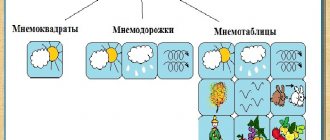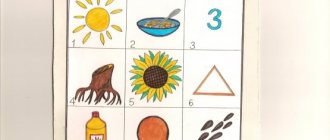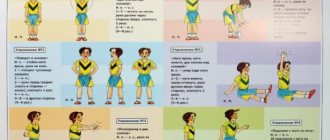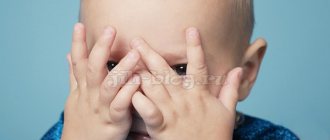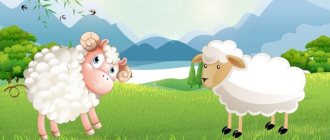Finger game “Autumn” in the younger group
The fingers went out for a walk - the children made walking movements with their fingers on a horizontal surface;
To collect leaves. - make raking and grasping movements with the hands;
Yellow leaf and red leaf,
Let's count them quickly. - clap their hands;
How many leaves did you collect in the bouquet?
One, and two, and three, four. - count by bending your fingers from the index finger to the little finger;
That's how many leaves we got! — raise their arms above their heads, rotate their hands left and right.
Preparation and performance of finger gymnastics
To effectively conduct the exercises, the teacher needs to consider the following points:
- Equipment, attributes. Currently, attributes for finger gymnastics and games can be found on the Internet by printing and cutting out caps, mini-masks of animals and other characters. For strength and better preservation, paper attributes should be covered with tape or transparent self-adhesive film. Embossed and “spiky” massage balls are also prepared in advance and children are first introduced to them so that during gymnastics the children are not distracted by exploring and looking at them. Natural materials are also widely used: chestnuts, walnuts.
- Scientific information. Since gymnastics for fingers and palms is carried out with elements of self-massage and acupressure, the teacher needs to get advice from a preschool nurse to find out how to carry it out correctly. If acupressure and finger exercises are included in the system of hardening procedures of a preschool institution, diagrams of their implementation indicating the sequence of exercises and points of influence for all age groups are stored in the nurse’s office.
- The text that accompanies the gymnastics. It can be both in poetry and in prose. The teacher can come up with the text independently or use the work of colleagues, recommendations of a methodologist, or a nurse. If gymnastics (massage) are presented in the form of a list of exercises without text, it is quite acceptable to accompany them not with poetry, but with prose in accordance with the content of the gymnastics. The text must be pronounced slowly, expressively, and emotionally, so that the children have time to complete the exercises and are interested in what they are doing. Gymnastics or massage will be of particular interest to children if a creative teacher comes up with a short fairy tale for them.
Table: massage with chestnuts accompanied by a text with a fairy-tale plot “The Adventures of a Chestnut Boy”
| Exercise | Teacher's words | Actions Performed |
| 1. Warming up your palms and fingers. | In one park there lived a little chestnut tree. Here it is. He found out that in our kindergarten the children love to massage with balls, and he wanted to make friends with the children, because the chestnut itself looked like a ball. | Children alternately stroke, squeeze and unclench the fingers of both hands, warming them up. |
| 2. Clenching and unclenching your fingers. | The chestnut rolled into the kindergarten, into our group, and immediately fell into the warm and kind hands of the children. | Children take chestnuts from the plates, squeeze them in their palms, open them slightly, and show the chestnuts to each other. |
| 3. Rolling a chestnut across the palm. | The chestnut wanted to play with the kids, roll on his palms like a bun. At first he rolled on one palm... then on the other. | Children place the chestnut on their open left palm, roll it with their right hand, then vice versa. |
| 4. Massage of elbows and shoulders. | The chestnut boy wanted to travel, so he first ran to his elbow and rode there. Then to the shoulder, and there he rode. And he returned to his fingers. | Children pinch the chestnut with the fingers of their right hand, move it from the wrist to the elbow of the left hand, make 3-4 circular movements, lift the chestnut to the shoulder, roll it over the shoulder, then return it to the palm. The same with the other hand. |
| 5. Free movements of the arms above the head. | The chestnut boy felt happy and wanted to dance. First in one handle, then in the other. | Children make “lanterns” over their heads, holding the chestnut in two hands alternately. |
| 6. Relaxation exercise. | The little chestnut was tired and wanted to rest. And our guys’ hands are also resting. | Children place chestnuts on plates and make “shaking” movements with their hands. |
| Notes. | The text may vary depending on the exercises performed. The teacher must ensure that children change hands and chestnuts in them on time. Those who cannot roll chestnuts along the shoulder and elbow, move them by holding them with their fingers. |
Chestnut, walnut, hex pencil - all these items, when used skillfully, will help children develop hand motor skills
Rules for finger gymnastics
Children are introduced to new gymnastics or finger massage in the following sequence:
- The teacher draws attention to the toy, the illustration, which corresponds to the theme of gymnastics, and informs them that they will get acquainted with new exercises. You can involve a game character (Dunno, Matryoshka) and invite children to learn gymnastics with them.
- The teacher leisurely reads a poetic text or a nursery rhyme, consistently demonstrating the exercises to the children.
- Children perform gymnastics, the teacher reads the text and at the same time shows the movements again.
- The teacher sums up, praises the children, draws their attention to how dexterous and skillful their fingers will become if they always do the exercises so diligently.
If gymnastics is already familiar to children, the teacher should encourage their independence, support the desire to partially pronounce poetic texts, and recall the sequence of exercises. In this type of activity there is also a place for creativity and imagination: children can, under the guidance of a teacher, make some attributes, finger caps, and come up with new movements that reveal the character of a particular hero. After completing the exercises, children can play with the characters, freely develop the plot, and perform several simple actions (the characters walk, dance, meet, communicate).
Bright, colorful and accessible attributes are a sure guarantee of preschoolers’ high interest in finger exercises
To instill in children a love of independent finger games, the teacher must place equipment for them in a visible place and provide free access to it. You can also give children chestnuts, walnuts, small balls, large beads on a tightly tied braid for independent practice. But peas, beans and other small materials for independent activities are not given to children, since these items can pose a health hazard. The children work with them under the strict supervision of an adult.
When performing gymnastics and self-massage, one should not forget the important rules:
- Children need to be adjusted, organized, switching their attention from other activities.
- The exercises always begin by warming up the hands, palms, and light stroking until a feeling of warmth appears.
- The exercises are performed 3–5 times with both hands or alternately with the right and left.
- It is necessary to monitor the correct position of the hand and fingers, and the precise execution of movements.
- The teacher performs all exercises together with the children, adjusting to the pace of the group. Individual work is carried out with those who do not have time.
- During gymnastics, children should be relaxed and in a good mood. This is facilitated by the soft, friendly tone of the teacher. It is recommended to use quiet, calm music that does not interfere with the perception of words.
- A separate lesson of one finger gymnastics lasts no more than 5–6 minutes, otherwise children will get bored and lose interest in it. If the teacher introduces gymnastics into educational activities (EAC), then you can take 2-3 complexes and distribute them evenly during the lesson. In this case, gymnastics is reduced to 2-3 minutes by eliminating the introductory and final parts. More than 3 different types of gymnastics in the middle group can be used in a thematic lesson about finger games or in an open lesson, the purpose of which is to introduce colleagues to this type of work.
- The learned complexes are repeated throughout the school year, gradually becoming more complex (increasing the number of repetitions and accuracy of movements). At the same time, new, more complex complexes are being added.
Forms of gymnastics:
- Frontal (with all children in the group). It is effective during learning, during visual arts classes, and during walks in the fresh air.
- Subgroup. It is carried out with part of the group (5-8 people) during the time allocated for free play indoors at the request of the children. Children who are not involved in gymnastics are involved in other activities under the supervision of an assistant teacher or the teacher himself (drawing, playing with construction sets, toys, looking at books, illustrative material).
- Individual. Exercises are performed by 1–2 children under the supervision of a teacher. They work individually most often with children who experience difficulties with frontal and subgroup teaching.
With the whole group of children, gymnastics is carried out more often in class, and with a subgroup - in their free time.
Table: card index of finger gymnastics classes in the middle group of preschool educational institutions
| Topic and tasks | Content |
"Tom Thumb."
| Finger gymnastics move. Warm up fingers: flexion and extension. You can use rubber toys with squeaks for this exercise. Exercise 1. Palms on the table (on the count of “one-two”, fingers apart - together.) Exercise 2. Palm – fist – edge (on the count “one, two, three”). Exercise 3. Fingers shake hands (at the count of “one-two-three-four-five” the fingers of both hands are connected: thumb with thumb, index with index, etc.) Exercise 4. Little man (index and middle fingers of the right, and then left hands run across the table). Exercise 5. Children run a race (movements are the same as in the fourth exercise, but perform both hands at the same time). |
"Goat, hares and squirrel."
| Progress of finger gymnastics Warm up fingers: flexion and extension. You can use rubber toys with squeaks for this exercise. Exercise 1. Goat (extend the index finger and little finger of the right hand, then the left hand). Exercise 2. Little goats (the same exercise, but performed simultaneously with the fingers of both hands). Exercise 3. Glasses (form two circles from the thumb and index fingers of both hands, connect them). Exercise 4. Hares (extend the index and middle fingers upward, connect the thumb, little and ring fingers). Exercise 5. Trees (raise both hands with palms facing you, fingers spread wide). |
"Kitty".
| Progress of finger gymnastics Warm up fingers: flexion and extension. You can use rubber toys with squeaks for this exercise. Exercise 1. Flag (pull your thumb up, connect the rest together). Exercise 2. Birds (alternately the thumb is connected to the rest). Exercise 3. Nest (connect both hands in the form of a bowl, clench your fingers tightly). Exercise 4. Flower (the same, but the fingers are separated). Exercise 5. Plant roots (press the roots - hands with the backs of each other, lower your fingers down). |
"Friends". Development of skills:
| Progress of finger gymnastics Warm up fingers: flexion and extension. You can use rubber toys with squeaks for this exercise. Exercise 1. Bee (rotate the index finger of the right and then the left hand around). Exercise 2. Bees (the same exercise is performed with both hands). Exercise 3. Boat (point the ends of your fingers forward, press your hands with your palms to each other, slightly opening them). Exercise 4. Sun rays (cross your fingers, raise your hands up, spread your fingers). Exercise 5. Passengers on the bus (crossed fingers pointing down, backs of hands up, thumbs up). |
In addition to finger gymnastics, the classes widely use games for fingers and palms on a wide range of topics, often combined with the theme of the main lesson. High activity and interest of children in this type of activity is ensured by funny, easy-to-remember poems that accompany every movement.
Table: examples of poetic works for finger games in the middle group
| Mushrooms. Red, red fly agaric - (We connect our fingertips - we draw a mushroom hat). White speckled pattern. (One hand is a “mushroom cap”; with the index finger of the other hand we show “speckles”). | Cloth. I'll put on boots, (Point to legs, torso, head). Jacket and hat. And on each hand (One hand with straightened fingers up, the other runs along the little finger and the edge of the palm, showing the direction of putting on gloves). I'll pull on the glove. (Change hands). |
| Shoes. We put shoes on our feet to run on the track. (They “walk” on the table with two fingers.) Repeat the words after me: (Clench and unclench your fingers). Leg - one, leg - two! (Place two fingers on the table and raise one at a time.) They buy in the store (Clench and unclench their fingers). And Dad, Mom, Brother and I put them on their feet - (Bend their fingers). The whole family loves shoes. (“They walk” their fingers on the table). | Dishes. From the plates, as one, (Palms together in front of you “plate”). We eat soup with spoons. (Rotational movements of the hand with an imaginary spoon). We eat cutlets with a fork (the index and middle fingers are straightened, the thumb holds the ring and little fingers - “hold the fork”). The knife cuts our omelettes. (“Cut” with a straight palm back and forth). |
| Food. Knead the flour into the dough (Clench and unclench your fingers). And we sculpted from the dough (Clap with palms, “sculpt”). Pies and buns, (Alternately extend the fingers, starting with the little finger). Butter cheesecakes, buns and rolls - (Both palms are turned up). We will bake everything in the oven. Delicious! (Stroke bellies). | Winter. Snow falls on the houses (we spread our arms to the sides, palms down). Streets and rooftops. (Hands like a house). Winter is quietly coming towards us, (Finger to lips. “Let’s go” with the index and middle fingers of one hand). We can’t hear her... (Hand behind ear). |
| Furniture. We slept on the crib, (Hands under cheeks). Things have already been put away in the closet. (We move our hands freely - “putting things away”). We sat on a chair (we cover the fist of the other with the palm of one hand). And we ate at the table. (Rotational movements of the hand with an imaginary spoon). | Transport. Cars are walking along the highway (Turn an imaginary steering wheel). Tires are rolling on the asphalt. (Elbows are pressed to the body, palms move parallel to each other). Don't run along the road (they shook a finger). I'll tell you: "Beep." (The hand is clenched into a fist, the thumb is straightened - “signal”). |
| Quote from: https://infourok.ru/kartoteka-palchikovoy-gimnastiki-dlya-sredney-gruppi-1716259.html |
Photo gallery: attribute templates for games to develop fine motor skills
Figures of characters can be put on fingers like caps Figures with slots for “legs” allow children to “drive” their character along a table or other flat surface Figures that are put on like a thimble are no less popular
Game "Centipede" for younger preschoolers
A centipede is walking along an autumn path. - children move in one place with marching steps;
Suddenly drops began to fall from the sky. - tap their fingers on the open palm of the other hand;
Oh, forty paws will get wet!
I don’t want a cold, I’ll go around the puddles in an instant,” they make a small circle, imitating going around a puddle;
I won’t bring dirt home, I’ll shake it off all my paws.
And I stomp into the hole, and I stomp loudly. — they walk in place, raising their legs high, knocking them on the floor.
Games about the child's body
Harmonic
Wall, wall (point to cheeks) Ceiling (forehead), Two steps ("walk" along lips with fingers) And a bell. (nose) - Ring! (press on nose) The owner of the house? - Ring! (press on nose) Is the accordion ready? - Ring! (press on nose) Can we play? (lightly tickle the child)
These are our little eyes. Exactly. (show eyes) These are our ears. Exactly. (show ears) This is the nose, this is the mouth. (show nose, mouth) Back. Here's the belly. (show back, belly) Clap-clap with your hands. (clap your hands) Stomp-stomp with your feet. (stomp your feet) Oh, we're tired, let's wipe our brow! (run your palm over your forehead)
Face
Forest, (point to hair) Glade, (forehead) Hill, (run finger across nose) Pit. (child opens mouth) Break (point finger at chin) Explosion. (lightly tickle the neck)
Game "Fly agaric" for the younger group
A fly agaric with a beautiful hat grew in a forest clearing. - students imitate a mushroom, move their legs, raise their arms above their heads, and bend them in the shape of a “house”;
The mushroom picker is waiting and waiting, going into the basket. - clap their hands;
But we know for sure that fly agaric should not be eaten. - make a threatening movement with the index finger.
The importance of finger gymnastics in working with children
Active ones stimulate improvement of brain function and develop speech centers.
Important! Nowadays, there are often cases when preschool children have speech delay. To prevent this, it is necessary to carry out these trainings every day. To develop hand motor skills, there is a specific direction - finger gymnastics for children 6-7 years old.
Finger gymnastics and its meaning for children 6-7 years old
This type of entertainment has a good effect on children's health.
On a note! During finger gymnastics, parents (mom, dad) and children form good relationships.
By working with a child, the parent and teacher not only improve hand motor skills, which develops the brain well, but also establish a connection between both participants in the process. Teachers use this type of prevention during:
- Morning exercises;
- Physical culture, music;
- Mathematics lessons in the preparatory group.
Preparatory group gymnastics forms and develops:
- finger dexterity;
- speech centers;
- memory, imagination, attentiveness;
- evoke positive emotions;
- development of touch;
- independence skills develop;
- artistry.
Game "Autumn Leaves" for middle preschool age
The variegated leaves swirl beautifully—the children smoothly and leisurely move their brushes left and right;
They lie calmly and quietly on the ground. - slowly lower their hands;
When we walk, there is a rustling noise under our feet - we join our palms, rub one against the other;
As if they want to fly above the earth again. - slowly raise their hands, calmly swing them in different directions.
“In the autumn forest” for middle group preschoolers
Early in the morning we got up and gathered to pick mushrooms; the children moved in place at a marching pace;
They bent down, squatted, and suddenly found the boletus. - squat 2-3 times;
One, two, three - bend over! - bend over 2-3 times;
Basket, fill up!
Look, there are nuts on the tree!
Who will jump to the top branch? - jumping up;
He will reach the branch,
Who will do a good job? - stretch out on tiptoes with arms raised;
We had a nice walk in the forest and collected a full basket. — they walk briskly in place.
Recommendations for performing exercises
- Prepare your child for this type of training. It is necessary to discuss its contents in advance and practice several gestures.
- An adult authorized to do the training should prepare a text in advance.
- Before starting work, you need to warm up your palms by stroking.
- The presenter shows how interesting this type of entertainment is.
- It is imperative to complete the assigned tasks at a slow pace.
- The child must perform the technique correctly; he needs help.
- It is important that all exercises performed bring only joy to the child.
- Each task is performed for 2-3 minutes, alternating 3 days.
- Daily workouts.
- Easy tasks are used to develop interest.
- Gradually replace 2-3 exercises, depending on the degree of difficulty.
- Be sure to use color images and musical accompaniment.
For children 6-7 years old, training accompanied by songs and rhymes is suitable. For development, a good task would be a shadow theater. If parents decide to exercise their fingers on their own, they must be in a good mood. Children remember everything, and interest in subsequent lessons will depend on the first lesson.
Important! The speed of execution should not be fast, but there should be no pauses. It is necessary to increase the speed gradually.
Learning to memorize and retell for the development of auditory memory
“Autumn has come” - a game for a middle preschool group
Gloomy autumn has come,
It brought cold rain. - children tap the fingers of one hand on the palm of the other;
The garden suddenly turned yellow,
The wind ruffled the leaves. - rubbing one palm against the other;
You can't hear bird songs,
We will wait until spring for them. - move the brushes up and down.
Activities using finger games and gymnastics
Games and exercises for the development of fine motor skills can be used in organized educational activities in all educational areas. Particularly successful would be the choice of a game or gymnastics, the topic of which coincides with the topic of the lesson. In this way, children will consolidate their acquired knowledge.
The total duration of the lesson should not exceed the limits recommended by sanitary standards:
- 20 minutes. for subject classes;
- 25 min. for integrated and complex.
The structure and time frame of the lesson are also preserved:
- Introductory part (organization of children, greeting, interesting moment). Up to 2 min.
- The main part (games, conversations, exercises, looking at illustrations, reading works, communicating new things or consolidating learned material). 16–20 min.
- The final part (summarizing, encouragement, analysis of the lesson). Up to 2 min.
Finger game “Autumn” in the senior group
The breeze flies quickly - the students move their hands smoothly and slowly, imitating waves;
In the park he counts the leaves:
Here from the oak tree,” bend the little fingers on both hands;
Here from the maple,” bend the ring fingers;
Here are the ones carved from mountain ash - the middle ones are bent;
Here are the golden ones from the aspen tree, - they bend their index fingers;
But I found a birch one - the big ones bend;
He began to circle above the ground. - raise their arms above their heads and swing them in different directions.
Game “What do we wear in the fall?” for older group
When getting ready to go for a walk, children connect each right finger with the big left one;
We put on clothes. - combine each left finger with the right thumb;
T-shirt, pants - connect each right finger to the left little finger;
Jacket, scarf, coat. - combine each left finger with the right little finger.
"Birds Fly Away" for older preschoolers
Autumn walks on the ground - the pupils touch the horizontal surface with their right fingers one by one;
For the whole winter until spring - touch with left fingers;
Flocks of birds fly away: - touch again with their right fingers;
Starlings, ducks, blackbirds,
Larks, nightingales. - touch with left fingers again.
“Autumn in the Park” for older preschoolers
Autumn has settled in the park - the pupils are fingering the horizontal surface;
I have prepared gifts: - put your palms in a “bowl”;
Red earrings - rowan, - bend the little fingers of both hands;
The dress is colorful - aspen - the ring fingers are bent;
Dubu - golden outfit - bend the middle ones;
Well, fruits are for the guys. - bend the index fingers.
Principles of organizing gymnastics for fingers and palms
When conducting finger gymnastics in the middle group of a kindergarten, the teacher should rely both on the general principles used in organizing the activities of pupils, and on the mental and physiological characteristics of children in the fifth year of life.
The organization of gymnastics is based on the principles:
- Systematic and gradual. Gymnastics classes are held regularly, with gradual complication and mandatory repetition of exercises.
- Comfort and voluntariness. Classes should bring children pleasure and joy, and participation in them is always free, at the request of the children. In order for children to perceive gymnastics with interest and actively participate in it, the teacher uses various techniques: artistic expression; attracting a game character; colorful paraphernalia (bright balls, caps with “portraits” of animals, fairy-tale characters.
- Availability and feasibility. All materials (poems, nursery rhymes, illustrations, pictures) that the teacher uses must be appropriate for the age of the children, be familiar to them, and understandable, so as not to cause hesitation or reduce the dynamism of the game.
- Individual approach. Children of the middle group, unlike the younger and nursery groups, no longer need the teacher to teach them exercises every step of the way, taking the child’s hand in his own and manipulating his fingers. Four-year-olds can easily repeat a movement that is shown to them 1-2 times. But the teacher must keep all the children in sight, and if some of the exercises cause difficulties for some of them, or the children perform them incorrectly, work should be done with such children to reinforce the correct position of the fingers during the exercise. This will help kids in other activities (teach children how to properly hold a spoon, pencil, and manipulate objects in games).
Compliance with these principles will help the teacher carry out this type of activity with the greatest benefit for the kids, in a fun way and at the right pace.
When performing gymnastics for fingers in the middle group, it is necessary to pay attention to the synchronization of movements of both hands, whereas a year earlier children could perform movements (rolling a ball on their palm, “walking” with their fingers along the path) with one hand. To do this, children are taught to perform the movement first with one (right) hand, then with the other, and then with both hands together. Gymnastics includes as many exercises as possible on the interaction of hands: tapping, stroking, patting, connecting fingers in pairs. Actions must be performed either simultaneously, or with both hands alternately, for which sometimes the text must be repeated twice. You cannot limit yourself to performing exercises with one hand.
In the middle group, the teacher is given a new task: to teach children to coordinate the movements of both hands
Finger game “Autumn” in the preparatory group
The cold wind plays pranks - the children, pursing their lips like a tube, blow out air;
A heap of leaves swirled. - spread out the right and left fingers, blow on them;
The leaves began to spin quickly, waving their raised arms;
Then they sat down on the grass.
The rain ran across the leaves - they tap their fingers on the open palm of their other hand;
He tapped them with hailstones, folded his fingers into a “pinch” and tapped them on the other palm;
He punched holes in them. - knock with a fist on an open palm;
They were dusted with snow; they were slowly waving their tassels;
Covered with a blanket. - fold your palms.
Types of exercises
All games are divided into three groups.
- Exercises that affect the hands. What we get from this type of activity:
- The skill of relaxing and tensing muscles develops;
- Imitative ability develops;
- Developing the skill of keeping fingers in one position for a while;
- Switch from a certain subject to another.
- Statistical work for fingers. These exercises help to carry out early experience in a certain direction, at a high level.
- Dynamic work for fingers. What will happen if you follow these exercises:
- Movement coordination will develop;
- Oppose thumbs to others.
Unconventional finger games
“Non-traditional” finger games are games with different objects. That is, you can take any object in the child’s field of vision. For example, it will be a pencil.
On a note! It is advisable that both parents and children take a pencil in their hands and begin to rub it palm against palm, while the most important thing is to say either poems or nursery rhymes between their fingers.
Here you can use a special “hedgehog ball”, sand and many other items.
How to do gymnastics correctly
This may include the following training:
- Massage of hands and fingers with walnuts;
- Special massage brushes;
- Balloons. Various materials can be used for these types of entertainment:
- natural,
- household,
- junk.
Non-traditional games are a universal, didactic educational activity. The main goal of this entertainment is that the nerve endings in the fingers affect the minds of children. That is, the baby’s brain activity begins to work well.
Topic of the week: “My family” in the preparatory group
What are the effects of non-traditional forms of finger gymnastics:
- Speech development;
- Development of concentration;
- Preparing children for writing;
- Development of coordination.
For greater benefit of these games, you need to use rhymes, nursery rhymes, songs, and counting rhymes. As a result, the baby will receive a varied sensory experience.
Attention! When engaging in this type of play with your baby, a lot depends on the parents. Parents need to create a cozy and pleasant environment. This type of entertainment builds good relationships between children and adults.

